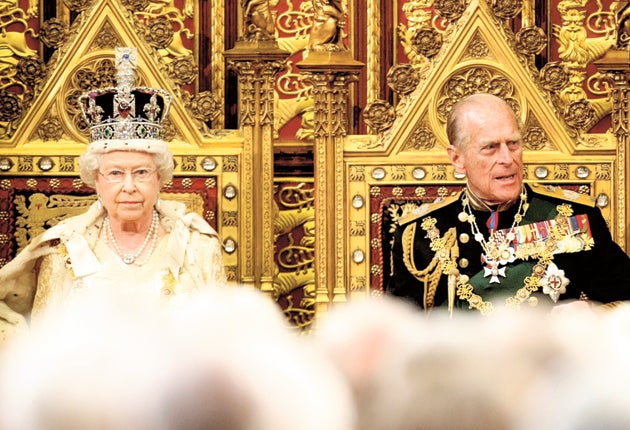The monarchy: A long fight for control, and for transparency

The divine right of kings and queens to govern their own affairs has been the source of tension between Parliament and the sovereign ever since Charles I ordered soldiers into the House of Commons to arrest Oliver Cromwell and his fellow conspirators.
It has taken nearly 400 years for the constitutional roles to be comprehensively reversed.
In 2005 ministers became so concerned about how the Royal Family spends public money that they sent consultants into Buckingham Palace to investigate the Queen's accounts.
The review took place while the Palace was pleading poverty and royal aides demanded more public money to pay for the upkeep of the royal buildings which cost the taxpayer £15m a year.
Some of the findings prompted the Department for Culture, Media and Sport to write to the Royal Household asking for an explanation as to why the proportion of "jobs" considered to be good value for money had significantly fallen from the previous year.
In a letter dated 21 July, officials also wanted to know why the mail costs associated with the Prince of Wales had inexplicably started to rise, leading to the question: "Please can you explain why the Prince of Wales's dispatches (cost of redirecting his mail) have increased and whether it is likely to continue."
There were further concerns about how the cost of craftsmen employed by the Palace "were seven times higher than the original budget" and why the Queen's debts had escalated.
The consultants' report found: "The total amount of debtors has increased from £983,000 to £2,773,000 since the beginning of the year. The breakdown of this figure does not explain this referring to a figure of £2,004,000 simply as other debtors. This is a significant sum, and I think we should ask for further details, and an explanation as to why such a large sum is outstanding."
The Royal Household was also chastised for not paying bills on time.
These awkward questions led to a flurry of activity at the Palace as aides scurried off in search of answers. A few weeks later they came back with a robust defence of the management of their budgets and their building projects.
On 26 July the director of the Queen's property section wrote to ministers asking for a meeting while insisting that there were "few opportunities" for contractors to be "lazy and uncompetitive". But even when pressed on the rising costs of the refurbishments of the palaces, aides continued to plead poverty.
The Royal Household official wrote: "As you may appreciate, the judgements we have had to make for the current year are unpalatable. Quite literally we have had to weigh rewiring against reroofing, balancing the demands of the departments with the need to repair the fabric of the buildings.
"There are no 'nice to have' excesses in our programme and large projects, such as cleaning and repair of the Quadrangle at Buckingham Palace, replacement of the Picture Gallery rooflight and repair of the Victoria and Albert Mausoleum, each of which is valued at over £1.5m, do not even feature in our Five Year Plan."
On Prince Charles, the Palace explained that his additional postal expenses would be permanent as he had decided to make more regular use of Birkhall, the Queen Mother's favourite Scottish retreat, which she left to Charles. Prince Charles and Camilla have been a frequent visitors to his home on the estate at Birkhall since their wedding.
In their report the property consultants suggested that the only way the Palace had been able to claim to meet targets for paying bills on time was to move the goalposts.
The consultants wrote: "As I have noted before, the targets are set at a very low level, which enables RHPS (Royal Household) to claim they are meeting the performance indicators, despite their falling short of the 28 days."
Concerns were also raised over a reduction of £26k in audit costs. The investigator wrote: "I recommend that you ask for details of this item, as, on the face of it, this could put probity at risk."
Then there was the thorny issue of how the Palace dealt with competitive tendering.
Said the report: "As I have pointed out in the past, decisions of this nature undermine the whole philosophy of competitive tendering.
The time to determine the suitability of tenderers is before the invitations are issued. To place organisations on tender lists when the team has reservations about their capabilities is a waste of the firms' time, brings the tendering process of the procuring agency into disrepute and presents a serious risk to probity of action."
By the end of 2004 the arguments over the funding of the Palaces had reached the highest levels.
In a letter dated 23 December 2004, Sir Alan Reid, The Keeper of the Privy Purse, wrote to the then Secretary of State for Culture, expressing his "deep disappointment" that there would be no increase to the Grant-in-aid which would remain at £15m.
He said: "... we are left with the suspicion that our ability historically to control and manage our cost base over many years is rewarded with nil increase. I will continue to keep you informed about the condition of the Estate, but regret it may well be inevitable that the buildings, comprising an important part of our heritage, will deteriorate for the remainder of this decade."
Subscribe to Independent Premium to bookmark this article
Want to bookmark your favourite articles and stories to read or reference later? Start your Independent Premium subscription today.

Join our commenting forum
Join thought-provoking conversations, follow other Independent readers and see their replies
Comments